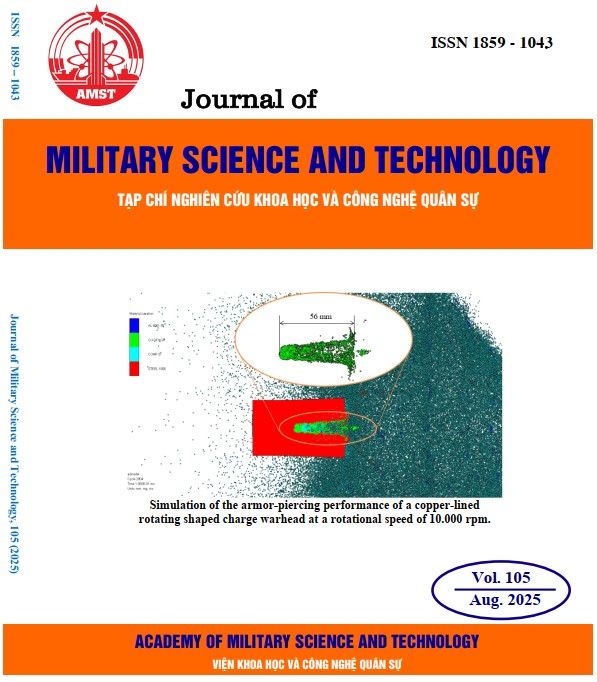Research on methods for measuring and controlling the modulation index of a frequency-modulated interferometer for high-precision displacement measurement
345 viewsDOI:
https://doi.org/10.54939/1859-1043.j.mst.105.2025.139-146Keywords:
FMI; Modulation index; LIAs; Measurement range.Abstract
This paper presents the theoretical foundation combined with experimental implementation to develop an algorithm for controlling and measuring the modulation index (m) of a Frequency-Modulated Interferometer (FMI) used for high-precision displacement measurements. In FMI-based displacement measurement systems, the modulation index m and synchronous demodulators (Lock-in Amplifiers – LIAs) are two critical factors that distinguish this method from traditional interferometric techniques. While the modulation index m determines the measurement range limit, the LIAs ensure high accuracy within that range. In FMI systems, the modulation index is embedded in all harmonic components. When measuring over a large range, the harmonic amplitudes vary, causing m to change with displacement, which reduces the signal-to-noise ratio (SNR) of the interferometric signal pairs and consequently degrades measurement accuracy. A method for controlling the value of m is proposed based on the relationship between the initial measurement range, m, and Bessel functions. Accordingly, the quantitative value of m can also be accurately measured based on the intensity ratios of consecutive even and odd interferometric signal pairs. An experimental verification of the method was conducted with an initial measurement range of 25 cm. The modulation index m was successfully controlled and measured as m = 2.575, then adjusted to reach the special value m = 2.631.
References
[1]. M. Pisani, “A homodyne Michelson interferometer with sub-picometer resolution”, Meas. Sci. Technol. 20(8) 084008, (2009). DOI: https://doi.org/10.1088/0957-0233/20/8/084008
[2]. J. Ahn, J.-A. Kim, C.-S. Kang, J.-W. Kim, S. Kim, “A passive method to compensate nonlinearity in a homodyne interferometer”, Opt. Express 17(25) 23299-23308, (2009). DOI: https://doi.org/10.1364/OE.17.023299
[3]. Y. Cai, B. Xie, Z. Wen, K. C. Fan, “A miniature laser diode interferometer with self-compensation of retroreflector’s motion errors for displacement feedback of small-sized micro/nano motion stages”, Measurement 186, 110172, (2021). DOI: https://doi.org/10.1016/j.measurement.2021.110172
[4]. H. Nozato, W. Kokuyama, A. Ota, “Improvement and validity of shock measurements using heterodyne laser interferometer”, Measurement 77, 67-72, (2016). DOI: https://doi.org/10.1016/j.measurement.2015.08.037
[5]. W. Hou, “Optical parts and the nonlinearity in heterodyne interferometers”, Precis. Eng. 30(3), 337-346, (2006). DOI: https://doi.org/10.1016/j.precisioneng.2005.11.005
[6]. L. Yan, B. Chen, Z. Chen, J. Xie, E. Zhang, S. Zhang, “Phase-modulated dual-homodyne interferometer without periodic nonlinearity”, Meas. Sci. Technol. 28(11), 115006, (2017). DOI: https://doi.org/10.1088/1361-6501/aa8547
[7]. T. T. Vu, H. H. Hoang, T. T. Vu, N. T. Bui, “A displacement measuring interferometer based on a frequency-locked laser diode with high modulation frequency”, Appl. Sci. 10(8) 2693, (2020). DOI: https://doi.org/10.3390/app10082693
[8]. T. T. Vu, M. Higuchi, M. Aketagawa, “Accurate displacement-measuring interferometer with wide range using an I2 frequency-stabilized laser diode based on sinusoidal frequency modulation”, Meas. Sci. Technol. 27(10) 105201, (2016). DOI: https://doi.org/10.1088/0957-0233/27/10/105201
[9]. T.T.Vu,Y.Maeda, M. Aketagawa, “Sinusoidal frequency modulation on laser diode for frequency stabilization and displacement measurement”, Measurement 94, 927- 933, (2016). DOI: https://doi.org/10.1016/j.measurement.2015.12.021
[10]. Hoang Anh Tu, Pham Duc Quang, Vu Thanh Tung, Nguyen Thanh Dong, Tran Van Huong “High Precision Displacement Measuring Interferometer Based on The Active Modulation Index Control Method”, Measurement, Volume 214, page 112819-6, (2023). DOI: https://doi.org/10.1016/j.measurement.2023.112819







